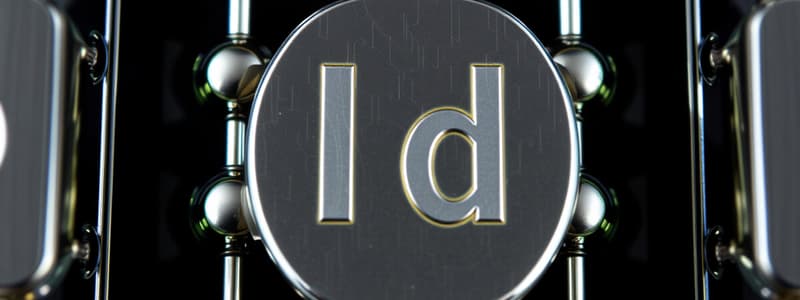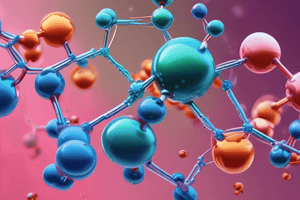Podcast
Questions and Answers
Which property of d-block elements generally increases as you move across the period?
Which property of d-block elements generally increases as you move across the period?
- Atomic radius
- Covalent radius (correct)
- Shielding effect
- Ionic radius
Which of the following statements about transition metals is incorrect?
Which of the following statements about transition metals is incorrect?
- They have unfilled d-orbitals.
- They can exhibit variable oxidation states.
- They often form complex ions.
- They have very high electronegativities. (correct)
What is the trend observed in the ionic size of d-block elements as you go down a group?
What is the trend observed in the ionic size of d-block elements as you go down a group?
- Remains constant
- Decreases
- Increases (correct)
- Increases initially then decreases
What is primarily responsible for the color of many transition metal compounds?
What is primarily responsible for the color of many transition metal compounds?
What happens to the covalent radii of d-block elements as you move across the period?
What happens to the covalent radii of d-block elements as you move across the period?
Which of the following d-block elements has an electron configuration that ends in 4s² 3d¹⁰?
Which of the following d-block elements has an electron configuration that ends in 4s² 3d¹⁰?
How does the ionic size of d-block elements change when going down a group?
How does the ionic size of d-block elements change when going down a group?
What characterizes the shielding effect in d-block elements?
What characterizes the shielding effect in d-block elements?
Which statement about the electron configuration of d-block elements is accurate?
Which statement about the electron configuration of d-block elements is accurate?
What distinguishes the transition metals within the d-block elements?
What distinguishes the transition metals within the d-block elements?
Flashcards are hidden until you start studying
Study Notes
d-block Elements
- d-block elements are a category of transition metals that include elements from the 3d, 4d, and 5d series.
- Notable d-block elements include Scandium (Sc), Titanium (Ti), Chromium (Cr), Manganese (Mn), Iron (Fe), Cobalt (Co), Nickel (Ni), Copper (Cu), and Zinc (Zn).
- These elements exhibit variable oxidation states and are known for forming colored compounds.
Covalent Radii and Atomic Size
- Covalent radii decreases across the period due to increased nuclear charge, enhancing electron attraction.
- Atomic size generally increases down the group due to the addition of electron shells, outweighing the increase in nuclear charge.
Ligand Effects
- Ligands, which can be anions or neutral molecules, influence the properties and reactivity of transition metals through coordination chemistry.
- The strength of the ligand affects the stability and color of the metal-ligand complexes formed.
Shielding Effect
- Electrons in filled inner shells can shield the outer electrons from the full effect of nuclear charge, impacting ionization energy and reactivity.
- Transition metals exhibit a significant shielding effect due to the presence of d-electrons, which contributes to their distinctive chemical behaviors.
Summary of General Trends
- Transition metals tend to have higher melting and boiling points compared to s-block and p-block elements.
- Their ability to form complex ions is attributed to accessible d-orbitals, making them essential in various chemical reactions and industrial applications.
d-block Elements
- d-block elements are a category of transition metals that include elements from the 3d, 4d, and 5d series.
- Notable d-block elements include Scandium (Sc), Titanium (Ti), Chromium (Cr), Manganese (Mn), Iron (Fe), Cobalt (Co), Nickel (Ni), Copper (Cu), and Zinc (Zn).
- These elements exhibit variable oxidation states and are known for forming colored compounds.
Covalent Radii and Atomic Size
- Covalent radii decreases across the period due to increased nuclear charge, enhancing electron attraction.
- Atomic size generally increases down the group due to the addition of electron shells, outweighing the increase in nuclear charge.
Ligand Effects
- Ligands, which can be anions or neutral molecules, influence the properties and reactivity of transition metals through coordination chemistry.
- The strength of the ligand affects the stability and color of the metal-ligand complexes formed.
Shielding Effect
- Electrons in filled inner shells can shield the outer electrons from the full effect of nuclear charge, impacting ionization energy and reactivity.
- Transition metals exhibit a significant shielding effect due to the presence of d-electrons, which contributes to their distinctive chemical behaviors.
Summary of General Trends
- Transition metals tend to have higher melting and boiling points compared to s-block and p-block elements.
- Their ability to form complex ions is attributed to accessible d-orbitals, making them essential in various chemical reactions and industrial applications.
Studying That Suits You
Use AI to generate personalized quizzes and flashcards to suit your learning preferences.




